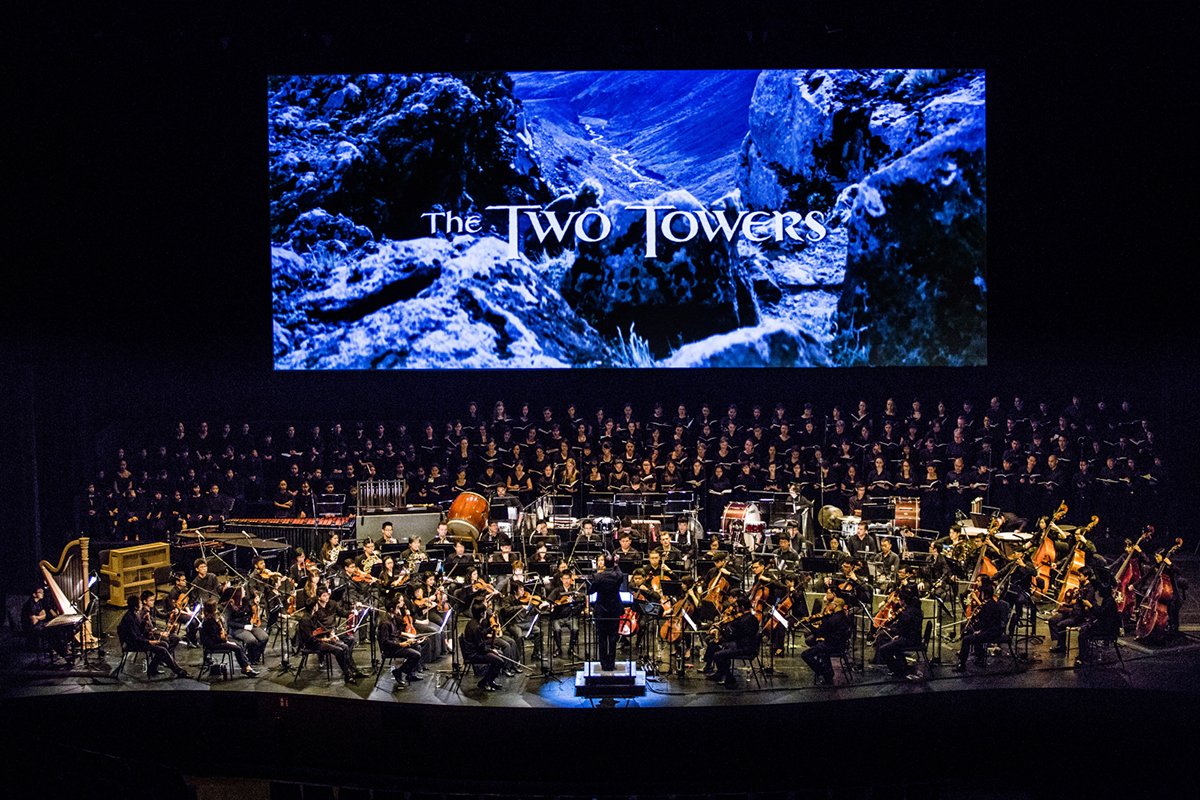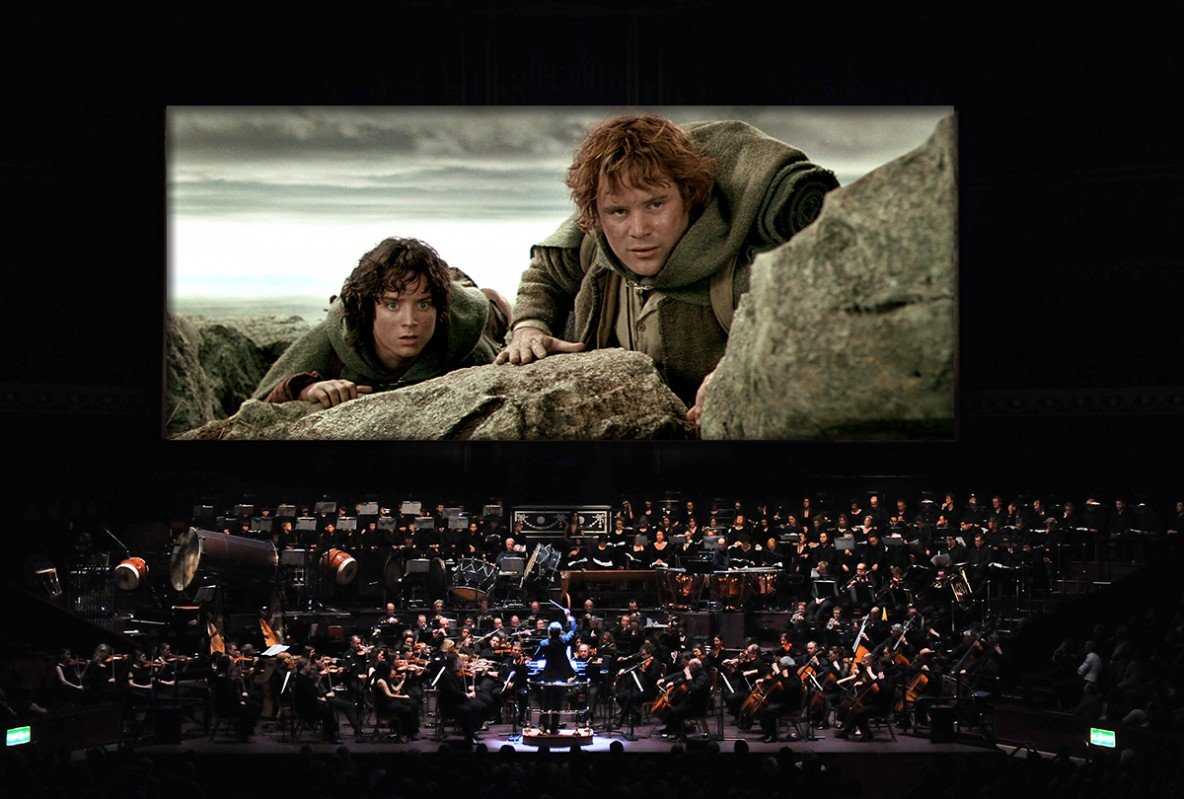Composer Howard Shore’s score to The Lord of the Rings: The Fellowship of the Ring introduced audiences to J.R.R. Tolkien’s Middle-earth and its resident cultures. In the saga’s second chapter, The Two Towers, the world has darkened, cloaked beneath the advancing shadow of Mordor and the threat of the evil One Ring.
The Two Towers opens with the Fellowship of the Ring broken three ways. Yet even as the band is pulled apart, Middle-earth’s cultures begin drawing together. So begins the gradual commingling of civilizations, as neatly compartmentalized social structures are dissolved, cultural strata are folded inwards and the free people of Middle-earth respond to the growing power of Mordor. The Two Towers’ score presents a more complex musical world than The Fellowship of the Ring. “The Fellowship of the Ring ends with the breaking of the Fellowship,” says Shore. “The Two Towers follows the fragments—the shards of the Fellowship. Three distinct stories are being told linearly now.”
In The Two Towers Shore develops the themes introduced in The Fellowship of the Ring and debuts figures for new cultures and characters—but it is the strengthening relationships within the amassed material that illustrates the increasingly entangled plight of Middle-earth. The Shire’s themes, for example, are carried by Merry and Pippin into Fangorn Forest, where they mix with the austere music of the tree-herding Ents. The Ents relate to the cleansing waves of the Nature’s Reclamation theme, the purity of which is embodied in the voice of a boy soprano—the same vocal sound with which the Seduction of the Ring lures its victims. The One Ring’s principle motif, the History of the Ring, mixes with the Pity of Gollum as the wretched, obsessive creature leads Sam and Frodo—and his Precious—ever closer to Mordor. Sauron’s arsenal of material looms on the horizon, flaring and rearing up behind the blunt pestle of the Isengard music, which sprawls across Middle-earth’s plains, assailing the new Rohan Fanfare. The nobly braided Rohan music, in turn, finds an impressive ally: the Fellowship theme, now representing a reduced coalition of Man, Elf, Dwarf and Wizard. And so the connections continue, worlds of musical material circling and intertwining to create a vast ring of related themes. Across the grey slopes of Middle-earth, dusk deepens…
-Doug Adams
Doug Adams is a Chicago-based musician and writer. He is the author of the upcoming book The Music of the Lord of the Rings Films.
Part One:
Glamdring
Elven Rope
Uglúk’s Warriors
The Three Hunters
The Banishment of Éomer
Night Camp
The Plains of Rohan
Fangorn
The Dead Marshes
“Wraiths on Wings”
Gandalf the White
Edoras
The Court of Meduseld
Théoden King
The Forests of Ithilien
Intermission
Part Two:
One of the Dúnedain
The Wolves of Isengard
Refuge at Helm’s Deep
Voice of Saruman
Arwen’s Fate
The Story Foretold
Faramir’s Good Counsel
Aragorn’s Return
War Is Upon Us
“Where Is the Horse and the Rider?”
The Host of the Eldar
The Battle of the Hornburg
The Breach of the Deeping Wall
The Entmoot Decides
Retreat
Master Peregrin’s Plan
The Last March of the Ents
Théoden Rides Forth
The Tales That Really Matter
The Themes of The Two Towers
The One Ring
The One Ring is the story’s most proactive element. It has three distinct themes to represent its multidimensional nature.
The History of the Ring
In each film, this theme is first heard as “The Lord of the Rings” text appears, and reappears whenever the One Ring changes hands or marks significant progress in its journey. In The Two Towers The History of the Ring intertwines with Gollum’s Pity theme to illustrate his besetting obsession with the Ring.
The Seduction of the Ring
This theme, set in pure, clean choral tones and punctuated by rumbling bass drum strokes, represents the One Ring’s overwhelming allure.
The Evil of the Ring (Mordor/Sauron)
The third theme for the One Ring is an impervious snarl, limited to only four or five pitches, and unwavering in its focus. As with the other ancient powers of Middle-earth, Shore treats this theme to Eastern-tinted harmonic inflections suggesting a past age.
The Shire & The Hobbits
This theme is composed of basic and unadorned musical elements. The diatonic melody hints at a simple pentatonic scale while the harmonies present only a sensitive handful of chord changes. Because this tune is so simply and flexibly constructed, Shore is able to create several distinct variations out of the material. The reserved Pensive Setting and solemn Hymn Setting follow Frodo and Sam along their draining journey. More upbeat Playful and Lullaby variations join Merry and Pippin in Fangorn Forest. But in the end it is the more fully developed Hobbit’s Understanding line that speaks of the hobbits’ innate decency and perseverance.
Gollum
The Pity of Gollum (Sméagol’s Theme)
The enfolding triads of this melody represent Gollum’s wretched state of existence. By The Two Towers’ end they are reorganized and developed into “Gollum’s Song,” an upsetting articulation of Gollum’s warped psyche and his intentions towards the hobbits.
Gollum’s Menace
In The Fellowship of the Ring, the Shire’s music included, among other Celtic sounds, the hammered dulcimer. In The Two Towers the cimbalom, a distant relative of the dulcimer, represents Gollum’s heritage with twitchy chromatic figures. Eventually, the cimbalom becomes so strongly associated with Gollum that it appears alongside him, even when Gollum’s Menace does not.
The Elves
Lothlórien
The Lothlórien theme first appears in The Two Towers as a mysterious air aloft Galadriel’s concerned voice. It reappears, transformed into a militaristic anthem, when the elvish archers arrive at Helm’s Deep.
Rivendell
Rivendell’s theme bears a pronounced sadness in The Two Towers. The curving arpeggios conveyed a sense of age and wisdom in Fellowship. But the Elves are departing Middle-earth, and Arwen must choose between her immortality and her love for Aragorn.
THE DWARVES
The stout, gruff music of the Dwarves makes a quick cameo appearance in The Two Towers. During the film’s opening, which occurs during the Fellowship’s final moments in Moria, Howard Shore returns to the parallel harmonies and percussive choral writing native to the Dwarves’ stone halls.
THE WORLD OF MEN: ROHAN
The Rohirrim’s love for their land is embedded in every turn of phrase present in their theme. The songful melody is equally at home in proclamatory brass or the intense, thoughtful strains of the Hardanger, a Norwegian fiddle.
THE FELLOWSHIP OF THE RING
The Fellowship of the Ring was broken at the end of the first film. The Two Towers finds the members of the Fellowship scattered, but no less determined. Likewise, the Fellowship theme lacks the weight and heroism it once displayed, but it braves adversity unwaveringly.
ISENGARD
Tolkien scholars have long designated the conflicting goals of the industrial and natural worlds as one of The Lord of the Rings’major dramatic themes, and Shore’s material follows suit with Isengard’s asymmetrically mechanical music.
Isengard / Orc Theme
This is Isengard’s equivalent of the Fellowship theme, defying its burnished heroism with a sinewy show of impious force. It’s generally scored for low brass in their deepest registers. Like Isengard’s vicious culture, this theme is free of any artifice or decoration.
Five-beat Pattern
It is the Five-beat Pattern that most often represents Isengard’s presence in the film. This thunderous, hammering rhythm is scored for collections of metal bell plates, anvils, bass drum, Japanese taiko drum, and metal chains beating the strings inside a piano. In The Two Towers this malleable figure works its way deep inside opposing thematic material, attempting—virus-like—to corrupt and overpower.
MORDOR
Where the Shire’s music is familiar and warmly inviting, Mordor’s is morbid, threatening and sinister. This music favors low strings and the deepest registers of brass, fused to create a thick fog of overtones. Mixed choruses erupt into primal rhythms with abnormally close-spaced harmonies for a towering, ritualistic effect.
Mordor / Sauron (The Evil of the Ring)
The primary motif for Barad-dûr and Sauron is identical to the One Ring’s Evil theme. (The three are practically interchangeable story elements.) Shore uses this theme to portray the Ring’s “character,” but it also represents its effect upon the world.
THE ENTS
Appropriately, the Ents are represented by the wooden voices of the orchestra: bassoons, low strings, log drums and bass marimba. The rigid melody turns paired pitches back and forth, towards and away from each other, swaying to-and-fro like windblown branches.
NATURE’S RECLAMATION
The Nature music spends most of its existence resisting outward manifestations of emotion. It is rarely angry or vengeful. It is, instead, ethereal and restrained—resolute, perhaps, but as a musical balm for the imbalances in Middle-earth. But as the Orc themes infect the musical landscape of Middle-earth, Nature’s Reclamation is spurred to action. The Ents’ march on Isengard introduces a grand manifestation of Nature’s will. Nature, of course, is a timeless force, and so the theme remains vocal and step-wise, but now summoned into great swelling choral blocks accompanied by stern strings, winds and martial percussion. The music rises ceaselessly, ebbing and flowing, and ultimately overcoming Isengard’s percussive attacks through sheer force of presence.
Original text copyright © 2005-2014 by Doug Adams
Additional information available in the book The Music of the Lord of the Rings Films by Doug Adams, and online at musicoflotr.com.



